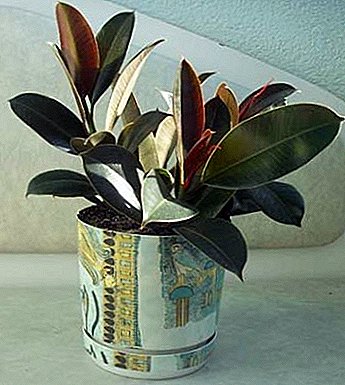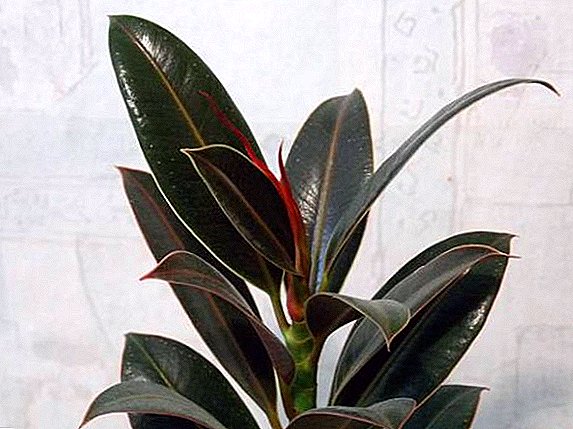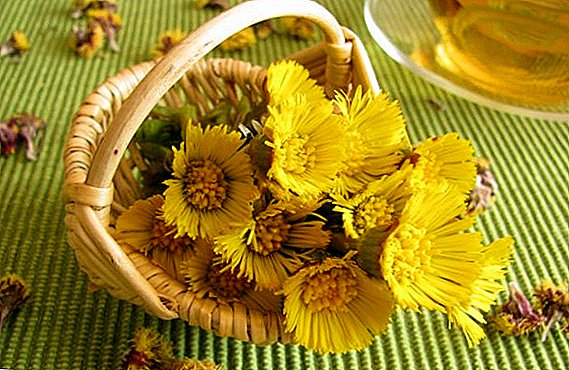
Ficus elastica Melanie belongs to the family of rubber moths.
This variety appeared relatively recently, but quickly gained popularity among fans of indoor plants, due to its compactness.
Like any other ficuses, it is unpretentious in conditions and can serve as decoration for any apartment or office.
Plant origin
Ficus rubber grows in a tropical part of Asia from India to Indonesia.
In nature, they are big tall trees with aerial roots, 30-40 meters high.
The ficus elastica Melanie is the most compact type of rubber-bearing rubber plants.
It was found in the greenhouse of one of the cities of Holland and is a mutation from another type of ficus elastica - Decor.
From the cuttings taken from it, new plants were grown that completely preserved the properties of their ancestor, which made it possible to isolate Melanie into a new variety.
ATTENTION! The main feature of this flower is not growing in height, in the form of a tree, but to the sides - a compact bush.This makes it possible to experiment with its crown, while maintaining a small occupied size.
Video about the ficus variety "Melanie":
Home care
The ficus of elastic Melanie does not need to create special conditions for him, and therefore he can be advised to novice growers.
Care after purchase
 Plants are usually sold in small shipping pots that are filled with a temporary substrate.
Plants are usually sold in small shipping pots that are filled with a temporary substrate.
Ficus Melanie replant best after 1 week after purchase.
The new pot is selected in size larger by 2-3 centimeters, than the previous one.
It is possible to fill it with a universal ground for ornamental plants, but it is best to take a special one for ficuses.
Watering in the first days should be done in small portions. In the future, go to a regular schedule with moderate watering.
Watering
The ficus is drought-resistant, and watering should be done only after the earth has dried by 2-4 centimeters.
The average frequency - 2 times per week. In winter, you can water weekly for 1 time.
These plants are more likely to suffer from excessive watering than from lack of water. If after the procedure the liquid remains in the pan, it must be drained.
ATTENTION! The main signal of excessive irrigation is the appearance of brown spots on the leaves, after which they begin to fall off en masse.
Bloom
The house practically does not bloom.
Crown formation
 In order for the plant to give the necessary shape and avoid pulling the branches, it must be cut.
In order for the plant to give the necessary shape and avoid pulling the branches, it must be cut.
The optimal time is the end of winter or the beginning of spring.
This should be done correctly - if you just cut off the top of the head, new leaves will start to develop nearby, but the flower itself will continue to grow upwards.
To stimulate branching, it is necessary to cut at least 4-6 sheets down.
The shoots that appear in this way can be rooted.
Soil and soil
Best suited specialized soil for ficuses.
But you can also use any subacidic or neutral earth, or you can make the substrate yourself.
To do this, mix one part of the leaf, sod land, humus, and half of the sand.
Be sure to down with a thick layer of expanded clay filled with drainage.
Transfer
The ficus belongs to fast-growing plants and needs regular transplantation in more spacious capacity.
The best time for this is the beginning of spring.
The procedure must be performed when the roots have completely filled the space in the previous pot or sprouted into the drainage holes.
New is selected on 2-3 centimeters larger in size than previously, from any material.
ATTENTION! It is not recommended to immediately plant the ficus Melanie in a much larger pot. This can lead to accelerated root formation to the detriment of the development of the ground part.
5-6 summer plants can not completely replant, but only to replace about 3 centimeters of topsoil.
A photo
In the photo ficus "Melanie":





Breeding
Occurs by cuttings that are cut in the spring of 10-15 centimeters in length from the top or stem fragments with 2-3 leaflets.
After cutting, it should be placed in a glass of water for some time to drain the milky juice.
Root the stalk can be sticking to the substrate, or by placing in a glass of water.
In the first case, the pot must be closed with a film to create favorable conditions. You can also dip the bottom tip into a root growth stimulator.
Temperature
The best temperature for the maintenance of the ficus elastic Melanie is + 18-25 degrees.
If the plant is in warmer air, the leaves should be periodically sprayed with separated water, treated with a damp sponge, or bathing in the shower.
In winter, the best temperature will be + 16-18 degrees.
It is not advisable to allow it to fall below +12 degrees, because the root system can freeze, and the plant in response to this will drop the leaves.
Benefit and harm
This variety can release rubber into the environment, which can cause problems in people who are allergic to latex and asthma.
At the same time, it actively cleans the air from a large amount of harmful impurities, which include benzene, phenol and trichlorethylene.
Diseases and pests
Melanie's ficus elastica is susceptible to infection with thrips, spider mites and shields.
To combat them, it is necessary to wash the leaves of the plant with a damp sponge with a mild soap solution, and then treat with chemicals.

In addition, the plant may experience the following problems associated with improper conditions:
- the leaves sagged - it is hot in the room, the air is dry. It is necessary to regularly spray the flower;
- leaf dropping - this can be due to two reasons: low air temperature or improper watering.
In the first case it is necessary to move the pot to a warmer place, remove it from the draft.
In the second - normalize watering. It is worth checking the condition of the soil and the root system, it may be necessary to transplant with the removal of rotted roots.
Brown spots on the leaves - burns from direct rays. It is necessary to create a shadow in the daytime.
Ficus elastica melanie - one of the popular types of ficus.
It grows a bush, and therefore gives a great opportunity to experiment on the crown.
The plant does not require any special conditions for itself, and therefore it can be recommended to those who are just starting to grow room flowers.
Useful video about watering and care at home for the ficus "Melanie":












